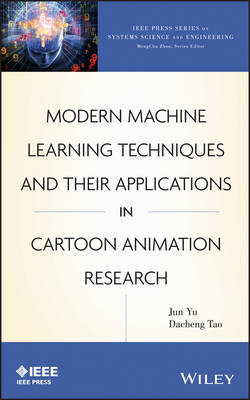
Modern Machine Learning Techniques and their Applications in Cartoon Animation Research
John Wiley & Sons Inc (Hersteller)
978-1-118-55996-3 (ISBN)
- Keine Verlagsinformationen verfügbar
- Artikel merken
JUN YU, PhD, is an Associate Professor in the Computer Science Department, School of Information Science and Engineering, Xiamen University, Xiamen, China. His current research interests include computer graphics, computer visions, and machine learning. He has authored or coauthored more than thirty scientific articles in journals including IEEE T-IP, IEEE TSMC-B, and Pattern Recognition. DACHENG TAO, PhD, is Professor of Computer Science with the Centre for Quantum Computation & Intelligent Systems and the Faculty of Engineering & Information Technology, University of Technology, Sydney, Australia. His research applies statistics and mathematics to data analysis problems in computer vision, data mining, machine learning, multimedia, and video surveillance. He has authored more than 100 scientific articles.
1 Introduction 1.1 Perception 1.2 Overview of Machine Learning Techniques 1.2.1 Manifold Learning 1.2.2 Semisupervised Learning 1.2.3 Multiview Learning 1.2.4 Learningbased Optimization 1.3 Recent Developments in Computer Animation 1.3.1 Examplebased Motion Reuse 1.3.2 Physicallybased Computer Animation 1.3.3 Computer Assisted Cartoon Animation 1.3.4 Crowd Animation 1.3.5 Facial Animation 1.4 Chapter Summary 2 Modern Machine Learning Techniques 2.1 A Unified Framework for Manifold Learning 2.1.1 Framework Introduction 2.1.2 Various Manifold Learning Algorithm Unifying 2.1.3 Discriminative Locality Alignment 2.1.4 Discussions 2.2 Spectral Clustering and Graph Cut 2.2.1 Spectral Clustering 2.2.2 Graph Cut Approximation 2.3 Ensemble Manifold Learning 2.3.1 Motivation for EMR 2.3.2 Overview of EMR 2.3.3 Applications of EMR 2.4 Multiple Kernel Learning 2.4.1 A Unified Mulitple Kernel Learning Framework 2.4.2 SVM with Multiple UnweightedSum Kernels 2.4.3 QCQP Multiple Kernel Learning 2.5 Multiview Subspace Learning 2.5.1 Approach Overview 2.5.2 Techinique Details 2.5.3 Alternative Optimization used in PAMSL 2.6 Multiview Distance Metric Learning 2.6.1 Motivation for MDML 2.6.2 Graphbased Semisupervised Learning 2.6.3 Overview of MDML 2.7 Multitask Learning 2.7.1 Introduction of Structural Learning 2.7.2 Hypothesis Space Selection 2.7.3 Algorithm for Multitask Learning 2.7.4 Solution by Alternative Optimization 2.8 Chapter Summary 3 Animation Research: A brief Introduction 3.1 Traditional Animation Production 3.1.1 History of Traditional Animation Production 3.1.2 Procedures of Animation Production 3.1.3 Relationship between Traditional Animation and Computer Animation 3.2 Computer Assisted Systems 3.2.1 Computer Animation Techniques 3.3 Cartoon Reuse Systems for Animation Synthesis 3.3.1 Cartoon Texture for Animation Synthesis 3.3.2 Cartoon Motion Reuse 3.3.3 Motion capture data reuse in cartoon characters 3.4 Graphical Materials Reuse: More Examples 3.4.1 Video Clips Reuse 3.4.2 Motion Captured Data Reuse by Motion Texture 3.4.3 Motion Capture Data Reuse by Motion Graph 3.5 Chapter Summary 4 Animation Research: Modern Techniques 4.1 Automatic Cartoon Generation with Correspondence Construction 4.1.1 Related Work in Correspondence Construction 4.1.2 Introduction of the Semisupervised Correspondence Construction 4.1.3 Stroke Correspondence Construction via Stroke Reconstruction Algorithm 4.1.4 Simulation Results 4.2 Cartoon Characters Represented by Multiple Features 4.2.1 Cartoon Character Extraction 4.2.2 Color Histogram 4.2.3 Motion feature 4.2.4 Skeleton Feature 4.2.5 Complementary Characteristics of Multiview Features 4.3 Graphbased Cartoon Clips Synthesis 4.3.1 Graph Model Construction 4.3.2 Distance Calculation 4.3.3 Simulation Results 4.4 Retrievalbased Cartoon Clips Synthesis 4.4.1 Constrained Spreading Activation Network 4.4.2 Semisupervised Multiview Subspace Learning 4.4.3 Simulation Results 4.5 Chapter Summary References
| Erscheint lt. Verlag | 3.4.2013 |
|---|---|
| Verlagsort | New York |
| Sprache | englisch |
| Maße | 150 x 250 mm |
| Gewicht | 3436 g |
| Themenwelt | Informatik ► Grafik / Design ► Film- / Video-Bearbeitung |
| Informatik ► Office Programme ► Outlook | |
| Informatik ► Theorie / Studium ► Künstliche Intelligenz / Robotik | |
| Technik ► Elektrotechnik / Energietechnik | |
| ISBN-10 | 1-118-55996-7 / 1118559967 |
| ISBN-13 | 978-1-118-55996-3 / 9781118559963 |
| Zustand | Neuware |
| Haben Sie eine Frage zum Produkt? |